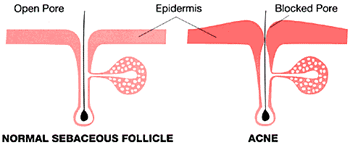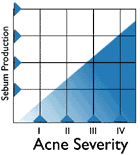|
Factors that Cause Acne
No one knows the exact cause of acne, but we do know that heredity plays a big role in two important factors that cause acne: our hormone activity and the oiliness of our skin.
Another important cause of acne is the buildup of skin cells that haven't shed properly (called retention keratosis), which line the sebaceous follicle and cause sebum (or skin oil) to back up and be trapped, while causing normal skin bacteria to be trapped under the surface as well. The combination of a plugged follicle and the warm, moist environment of your skin allows harmful infections to begin, causing pustules or pimples to form.
Conditions of Normal Skin Biology
Normal skin biology involves three basic processes:
The manufacture, dying process (keratinization), and shedding of skin cells.
The production of sebum by the sebaceous glands.
The control of resident bacteria.
The Manufacture, Keratinization and Shedding of Skin Cells
The skin surface is encased in layers of dry, dead cells that are mostly keratin, the fibrous proteins that form the basis of most epidermal tissue. These surface cells have migrated from deeper layers of the epidermis upward over a several-week period during which they have thinned, flattened, keratinized and prepared to separate or shed. This process of shedding is part of the normal, continuous renewal of the skin's surface.
The Production of Sebum by the Sebaceous Glands
A pilosebaceous follicle is the combination of a hair (pilo) follicle and an oil (sebaceous) gland. The skin folds directly inward, forming the tiny tubes (follicles) that encase very small hairs. The deeper part of this follicle receives the opening duct from a sebaceous gland, with the surface of the tube opening onto the skin (what we call a pore). The lining cells of this outlet tube shed in the same manner as normal, surface skin.
The Control of Resident Bacteria
Propionbacterium acnes (p. acnes) and staphylococcus epidermidis (s. epidermidis) are normal residents of the skin. These bacteria produce lipases and other enzymes that break down sebum triglycerides into free fatty acids. If normal skin biology is intact, p. acnes and s. epidermidis then are the not cause of acne. The bacteria and their products easily wash from the skin and the sebaceous follicle. The follicle, under normal conditions, is free from cellular debris, triglycerides, and excessive sebum bacteria. It is therefore also free from inflammation.
Abnormal Keratinization of Sebaceous Follicles
An individual with acne experiences a change in the process of keratinization of the sebaceous follicles, which results in an increased adherence and retention of surface cells that would normally be shed. This excessive retention plugs the follicle opening (pore) and blocks the outlet by which sebum normally escapes. Blockage of a large pore results in a blackhead; blockage of a small pore results in a whitehead. Whitehead formation is a crucial step in acne development. The closed pore blocking the sebaceous gland acts like a cork causing increasing pressure under the whitehead and resulting in swelling and tenderness.

Increased Sebaceous Gland Production of Sebum
An overactive sebaceous gland is always present in an acne patient. As excess sebum production increases, so does the severity of acne.
Androgenic hormone stimulation in both sexes at the time of puberty causes an increase in sebum production and an enlargement of the sebaceous glands. Side effects from ovarian hormones and birth control pills may also elicit increased sebaceous activity accounting for monthly breakouts of acne in women. Sun exposure, which increases oil production, and foods high in iodine - shellfish, seaweed, iodized salt and mineral supplements, and some multi-vitamins - have also been linked to what causes acne breakouts.
Abnormal Bacterial Flora
When p. acnes and s. epidermidis, which are normal residents of the skin, are trapped within the warm, moist environment of a sebaceous duct, they incubate and multiply. These bacteria produce lipases and other enzymes that break down sebum triglycerides into free fatty acids, which are quite irritating to the surrounding tissues.
The Inflammatory Process
A combination of cellular debris, free fatty acids, sebum and bacteria causes inflammation and then injury to the delicate sebaceous follicle. Other factors such as climate, stress, the use of topical medication or oily cosmetics, polluted air, harsh soaps, and abrasive scrubbing add to the inflammation and causes of acne. Squeezing and picking an acne lesion will result in a micro-infection, which may cause the follicle wall to rupture and allow the formation of buried acne cysts. Acne cysts are chronically inflamed, often cause permanent, unsightly scars and pits, and may require prescription medication. The immune system responds to this infection by sending white blood cells to engulf bacteria, resulting in the formation of pustules.
Grades/Severity of Acne
 The severity of clinical acne is classified by grades determined by the types and numbers of lesions present:
The severity of clinical acne is classified by grades determined by the types and numbers of lesions present:
GRADE I: Mostly blackheads (open) and whiteheads (closed) with few papules (small, conical elevation of the skin).
GRADE II: Open and closed comedones (clogged pore in oily skin) with many papules.
GRADE III: Open and closed comedones with papules and pustules (papule with pus).
GRADE IV: Open and closed comedones, papules, pustules, nodules and cysts.
*Note: Individuals with Grades III and IV acne should always see a physician for treatment.
|


 The severity of clinical acne is classified by grades determined by the types and numbers of lesions present:
The severity of clinical acne is classified by grades determined by the types and numbers of lesions present: